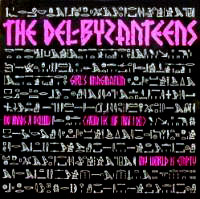When the latest batch of city slickers — Bongos, dBs, Raybeats, Fleshtones et al — staked their claim to a nice slice of the New York pop pie they left out one vital factor.
Chiming choruses, twanging charm, smiling beat and razor riffs all have their place, but where the hell was the missing link?
Idiosyncracy’s what we’re talking about — or the lack of it. In their eagerness to avoid the dominant street punk image of the city’s musical tradition, the new New Yorkers headed straight for the past, plundering Sixties pop and R’n’B, but forgetting those essential quirks. And where was the present?
Enter the Del-Byzanteens. Five individuals cloaked in a shroud of enigma, the Del-Bs — and what a great name — were responsible for « Girls Imagination », an exquisite 12 inch that captured the Melody Maker Single-Of-The-Week spot when released last july on the Beggar’s Banquet offshoot Don’t Fall Off The Mountain.
« Girls Imagination » floated in a middle-Eastern dreamworld, folding wistful melodies into a writhing twist. Ears pricked, noses sniffed; the scent of significant talent was in the air. « Lies To Live By » proves the vision is no lie. If a sharper group has come out of the East Coast in the last couple of years we’ve yet to hear it.
Divided into two distinctly separate sides, « Lies » shows the Del-Bs as a group with two personalities, the first a sophisticated breeze of mentholated pop, the second a wised-up bunch of tougher delights.
The pop side of the Del-Bs is nothing like the cynical opportunism practiced by some of Britain’s spivvier new stars, just a sensible exploitation of a natural shine — hear « War » or the haunting title track and you’ll soon get the drift.
It’s on the second side that the group get the chance to show the heavier side of their mettle; the new version of « Girls Imagination » is less Egyptian, more musclebound and as seductive as ever, « Apartement 13 » is an intriguing collage of assorted percussion, tape loops and random synthesizers colliding and drifting at will.
Finest moment, though, is « Welcome Machines », a slow-fuse burner that sizzles darkly against a backdrop of mysteriously wailing keyboards. The general feel of latent power behind early Can seems the only relevant reference point, and that’s only a vague approximation. This is mighty stuff.
Apart from its length — a mere 30-odd minutes — the only complaint about « Lies » is that it’s a collection of tracks rather than an LP. The Del-Bs, as displayed, almost revel in their versatility — hey, look what we can do, this is easy! — Instead of narrowing the focus for a clearer identity. Okay, most groups just define a style and repeat themselves endlessly. The Del-Bs sound too knowing to fall into that trap, though.
Go to it, boys.
Lynden Barber
Melody Maker
05/08/1982
The Del-Byzanteens
LIES TO LIVE BY
Don’t Fall Off The Mountain X-14




